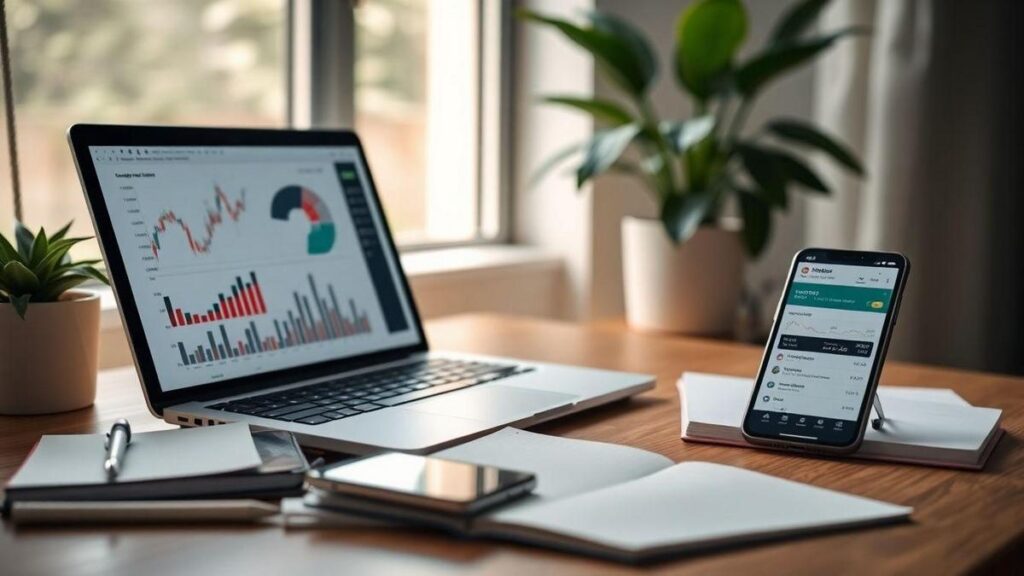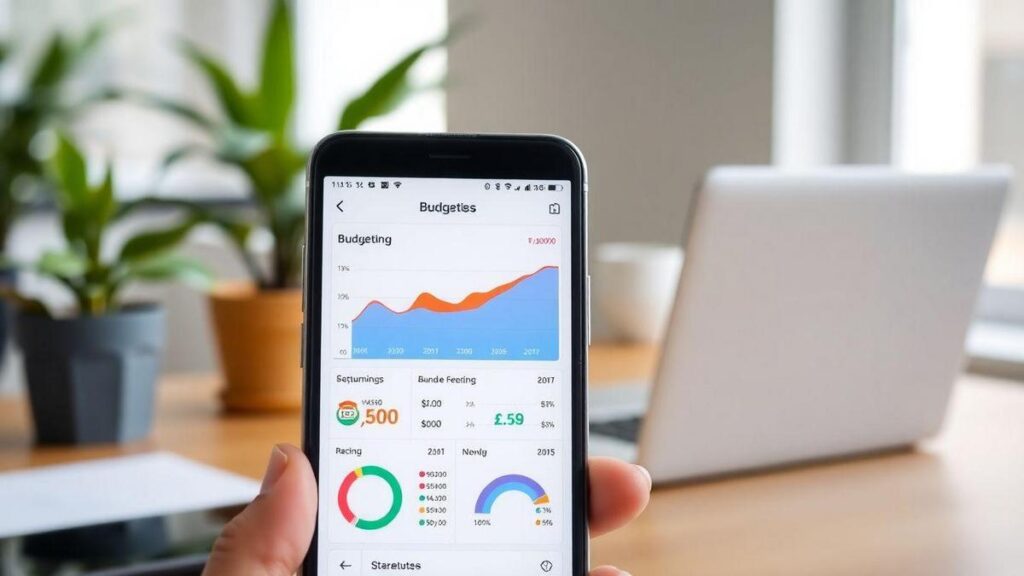In this article, I’m excited to share my journey with track spending: best money apps. I’ll dive into what these apps are and how they help me manage my finances. I’ll also highlight my favorite features and the benefits of using them. You’ll learn how to stay on top of your spending, avoid common mistakes, and save money for what truly matters. Let’s explore together how these handy tools can make financial planning a breeze!
Understanding the Basics of Track Spending Apps
What Are Track Spending Apps?
Track spending apps are handy tools that help me keep an eye on my money. They let me see where my cash is going, whether it’s for groceries, bills, or fun nights out. These apps can connect to my bank accounts and credit cards, making it easy to track spending without much effort.
How Do They Help Me Manage My Money?
Managing money can feel like juggling flaming torches sometimes. But with track spending apps, I get a clearer picture of my financial situation. They show me my spending habits, help me set budgets, and even remind me of upcoming bills. This way, I can make smarter choices about my money and avoid those “oops” moments when I overspend.
Benefits of Using Track Spending Apps
Using track spending apps comes with several benefits that can transform my financial life. Here’s a quick rundown:
| Benefit | Description |
|---|---|
| Easy Tracking | I can quickly see where my money goes each month. |
| Budgeting Help | These apps let me set budgets and stick to them. |
| Spending Insights | I get insights into my habits, helping me cut back. |
| Bill Reminders | I never miss a payment, thanks to reminders. |
| Financial Goals | I can set goals and track my progress in reaching them. |
In short, these apps are like having a personal finance coach in my pocket. They guide me to make better decisions and help me save for the things I really want.
Top Features of the Best Money Management Apps
Key Features I Look for in Budget Tracking Applications
When I think about the best money management apps, there are a few key features that really stand out. These features help me keep my finances in check and make budgeting a breeze. Here’s what I look for:
- User-Friendly Design: I want an app that’s easy to navigate. If I can’t find what I need quickly, it’s frustrating.
- Expense Tracking: The ability to track spending is crucial. I need to see where my money goes each month.
- Budgeting Tools: I love apps that let me set budgets for different categories. This helps me stay on track.
- Reporting Features: Visual reports showing my spending habits help me understand my finances better.
- Syncing with Bank Accounts: I prefer apps that can connect to my bank accounts for real-time updates.
How These Features Make Financial Planning Easier
These features make financial planning feel less like a chore and more like a fun challenge. For example, when I can easily see my spending habits, I can make smarter choices. If I notice I’m spending too much on takeout, I can adjust my budget to save more for a vacation.
Having budgeting tools means I can set limits on how much I spend in certain areas. This helps me prioritize my needs over my wants. Plus, those visual reports? They make me feel like I’m in control of my money. It’s like having a financial coach in my pocket!
Importance of User-Friendly Interfaces
A user-friendly interface is like a breath of fresh air. I don’t want to waste time figuring out how to use an app. When everything is laid out clearly, I can jump straight into managing my money. It takes away the stress and makes the whole process enjoyable.
In short, the best money management apps are the ones that make it easy for me to track spending, set budgets, and understand my finances without any headaches.
Comparing Popular Expense Tracking Software
My Favorite Expense Tracking Apps
When it comes to keeping tabs on my spending, I have a few apps that I absolutely love. They help me stay organized and save money. Here are my top picks:
- Mint: This app is like my personal finance buddy. It tracks all my expenses and categorizes them. Plus, it shows me where I can save.
- YNAB (You Need A Budget): I adore this app because it helps me set goals for my spending. It’s all about giving every dollar a job, which keeps my finances in check.
- PocketGuard: This app is super handy! It tells me how much I can spend after bills and savings. It’s like having a financial coach in my pocket.
How They Stack Up Against Each Other
Let’s see how these apps compare. Here’s a quick look at what each one offers:
| Feature | Mint | YNAB | PocketGuard |
|---|---|---|---|
| Cost | Free | Subscription Fee | Free or Paid |
| Budgeting | Yes | Yes | Limited |
| Reports | Yes | Yes | Basic |
| User-Friendly | Very Easy | Moderate | Very Easy |
Each app has its strengths. Mint is free and easy to use, while YNAB helps me budget better. PocketGuard is great for quick checks on what I can spend.
Factors to Consider When Choosing an App
When I’m picking an expense tracking app, I think about a few important things:
- Cost: Is it free or do I need to pay?
- Features: Does it have budgeting tools or reports?
- Ease of Use: Can I figure it out quickly?
- Support: Is there help available if I need it?
These factors help me choose the right app for my needs.
Tips for Effective Personal Finance Tracking
How I Set Up My Budget with Tracking Apps
When I first started tracking my finances, I felt like I was trying to solve a puzzle without all the pieces. But then I discovered some amazing tracking apps that changed everything. I began by choosing an app that was user-friendly and suited my needs. I looked for features like expense categorization, budget limits, and spending alerts.
To set up my budget, I followed these simple steps:
- List My Income: I wrote down all my sources of income.
- Identify Expenses: I tracked my monthly expenses using the app. This included everything from rent to coffee runs.
- Set Spending Limits: I assigned limits to each category based on my income and priorities.
- Review Regularly: I made it a habit to check my app weekly to see how I was doing.
I found that having a visual representation of my spending helped me stay on track. It was like having a financial GPS guiding me through my monthly journey.
Common Mistakes to Avoid While Tracking Expenses
As I navigated this new world of finance tracking, I stumbled upon a few common pitfalls. Here are some mistakes I learned to avoid:
- Ignoring Small Purchases: I used to think that small expenses didn’t matter. But they add up quickly!
- Not Updating Regularly: I learned the hard way that if I didn’t update my expenses often, I lost sight of my budget.
- Overlooking Subscription Services: I had a few subscriptions I forgot about, and they were draining my funds without me noticing.
By being mindful of these mistakes, I saved myself from unnecessary stress and overspending.
Staying Consistent with My Financial Goals
Consistency is key in reaching my financial goals. I realized that it’s like tending to a garden; if I don’t water it regularly, it won’t grow. I set reminders on my phone to check my budget and adjust it as needed. I also celebrated small wins, like sticking to my budget for a month. This kept me motivated to keep going!
In short, tracking my spending has been a journey of discovery. I’ve learned to be more aware of my financial habits, and I feel more in control.
Money-Saving Applications That Work for Me
Apps That Help Me Cut Down on Unnecessary Spending
When it comes to saving money, I’ve found that using money-saving apps has made a world of difference. These handy tools help me keep track of my spending, making it easier to spot areas where I can cut back. Here are a few apps that have really helped me:
- Mint – This app helps me see all my accounts in one place. It shows me where my money goes each month. I can set budgets and get alerts when I’m close to overspending.
- Honey – I love using Honey when I shop online. It automatically finds and applies coupon codes for me. It’s like having a personal shopper who always finds the best deals!
- YNAB (You Need A Budget) – This app helps me plan my spending before I even spend it. I can set goals for savings and see how much I can spend in each category.
How I Use These Apps to Save for My Goals
Using these apps isn’t just about cutting down on spending. They help me save for my goals too! Here’s how I do it:
- Setting Clear Goals: I use YNAB to set specific savings goals, like saving for a vacation or a new gadget. This keeps me focused and motivated.
- Tracking Progress: Mint shows me how much I’ve saved toward my goals. Seeing that number grow gives me a sense of accomplishment!
- Adjusting as Needed: If I find I’m not saving enough, I can quickly adjust my budget in these apps. This helps me stay on track without feeling overwhelmed.
Real-Life Savings from Using Money-Saving Apps
I’ve seen real savings since I started using these apps. Here’s a table showing my savings over six months:
| Month | Savings Goal | Actual Savings | Difference |
|---|---|---|---|
| January | $200 | $250 | $50 |
| February | $200 | $180 | -$20 |
| March | $200 | $220 | $20 |
| April | $200 | $300 | $100 |
| May | $200 | $150 | -$50 |
| June | $200 | $250 | $50 |
As you can see, I’ve had some ups and downs, but overall, I’m saving more than I thought I could!
The Future of Budgeting Tools for Mobile
Trends I See in Money Management Software
I’ve noticed some exciting trends in money management software lately. People are looking for ways to make their budgeting easier and more fun. One trend is the rise of mobile apps. We want to manage our money on the go! Apps are becoming more user-friendly, which is great for anyone, whether you’re a budgeting pro or just starting out.
Another trend is the focus on community features. Some apps let you share tips and goals with friends. This can motivate me to stick to my budget. Plus, seeing how others manage their money can give me fresh ideas.
How Technology is Changing Personal Finance Tracking
Technology is really shaking things up in personal finance tracking. I remember when I had to keep my budget on paper. Now, I can just pull out my phone and see where my money is going in an instant! With real-time updates, I can track my spending as it happens. This helps me make better choices.
Also, many apps now offer visual tools like graphs and charts. These tools make it easy to see where I’m spending too much. I can quickly adjust my habits and save more money.
The Role of AI in Budget Tracking Applications
Artificial Intelligence (AI) is becoming a game changer for budgeting apps. I’ve seen apps that use AI to give me personalized tips. For example, if I spend too much on coffee, the app might suggest cutting back or finding cheaper alternatives.
AI can also help me set goals. It learns from my spending patterns and can suggest how much I should save each month. This kind of smart help makes budgeting feel less like a chore and more like a fun challenge!
| Feature | Traditional Budgeting | AI-Powered Apps |
|---|---|---|
| Real-time tracking | No | Yes |
| Personalized advice | No | Yes |
| Visual tools | Limited | Advanced |
| Goal setting | Manual | Automated |

Olá! Sou Alan Marques, um entusiasta apaixonado por explorar e compartilhar os melhores aplicativos para facilitar a vida no mundo digital. Aqui você irá encontrar um Guia Global de Apps Essenciais, trago recomendações curadas, dicas práticas e análises de ferramentas que otimizam produtividade, criatividade e conexão. Minha missão é ajudar você a encontrar os apps perfeitos para suas necessidades, onde quer que esteja. Vamos juntos descobrir o poder da tecnologia ao alcance dos seus dedos!



